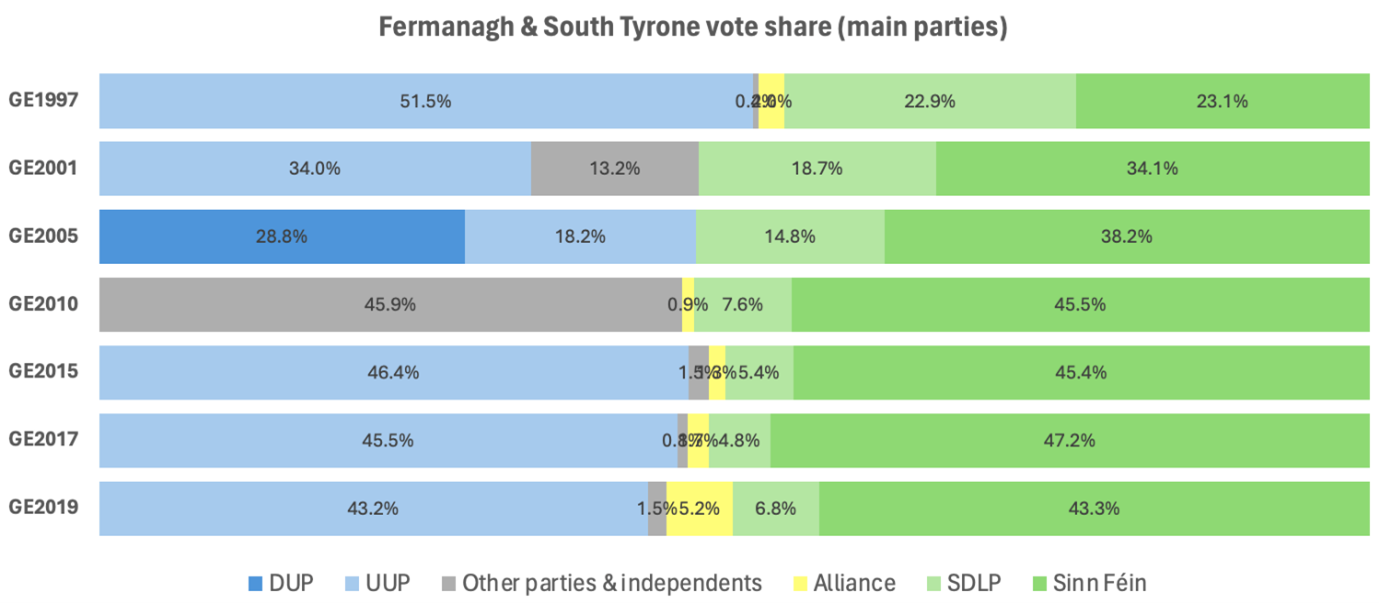#GE24 Constituency Profile: Upper Bann
ABOUT THE CONSTITUENCY
The result of the 2023 Review of Parliamentary Constituencies means that Upper Bann has transferred Aghagallon and Magheralin into Lagan Valley. It has also shed formerly split wards to other neighbouring constituencies: Ballinderry (to Lagan Valley) and Loughbrickland (to South Down). Mahon now lies fully within Upper Bann along with part of Loughgall. Overall the electorate has decreased by around 6,000 voters but won’t noticeably impact any party’s strength in the constituency at this Westminster poll.
PREVIOUS ELECTIONS
What used to be a tussle between the UUP and SDLP became a battle within unionism when David Simpson challenged UUP leader David Trimble in a bruising campaign for the 2001 General Election. Trimble’s majority dipped to 2,054 and by 2005, fortunes reversed and Simpson won the seat with a 5,298 majority. Simpson held this once-marginal now-safe seat until his retirement at the 2019 General Election with Carla Lockhart picking up the baton and consolidating her party’s vote. By 2017, Sinn Féin was the second largest party in Upper Bann with John O’Dowd picking up around a quarter of the votes polled in the last two elections.
2019 RESULTS
Carla Lockhart (DUP) won with a vote share of 41.0% and a majority of 8,210 over Sinn Féin’s John O’Dowd.
COMMENTARY
Upper Bann has the smallest field of the 18 Northern Ireland constituencies with just five candidates nominated.
Carla Lockhart is currently the only female MP in the DUP. She is seeking a second term by holding the seat that the DUP won from the UUP in 2005. Lockhart benefits from the fact that the TUV has decided not to field a candidate in this seat, meaning – unlike many of her colleagues – she won’t have to worry about pressure from that wing of unionism.
Her main challenger is Sinn Féin councillor and former MLA Catherine Nelson. Nelson previously stood for the Westminster seat in 2015, coming third. She will be hoping to build on the party’s strong performance at the 2022 Assembly election, when they outpolled the DUP, and better the party’s vote from 2019.
Alliance is running Eóin Tennyson for the second time, having come third back in the 2019 Westminster election, nearly tripling the party’s 2015 vote, and outpolling the now UUP leader Doug Beattie. Tennyson was a gain for the party at the 2022 Assembly Election and will be hoping to consolidate the recent gains made by the party.
This year, the UUP are fielding Councillor Kate Evans. This is the home patch of the party leader and something to watch out for is whether this one-time marginal seat for the UUP continues to see decline. The UUP were within touching distance of the DUP in 2015, yet by 2019 were 14,304 votes adrift.
The SDLP are running Councillor Malachy Quinn. The party lost an assembly seat in this constituency in 2022 and will be disappointed if they don’t see their support bounce back.
PREDICTION
DUP hold























